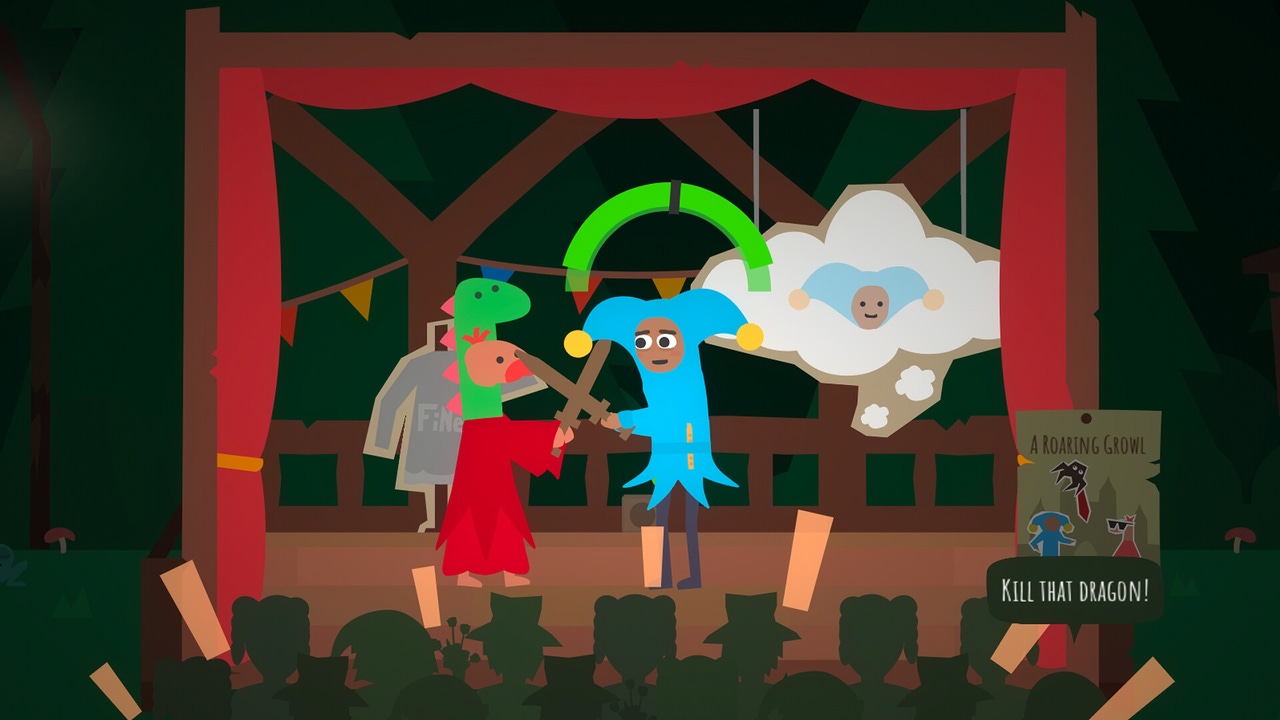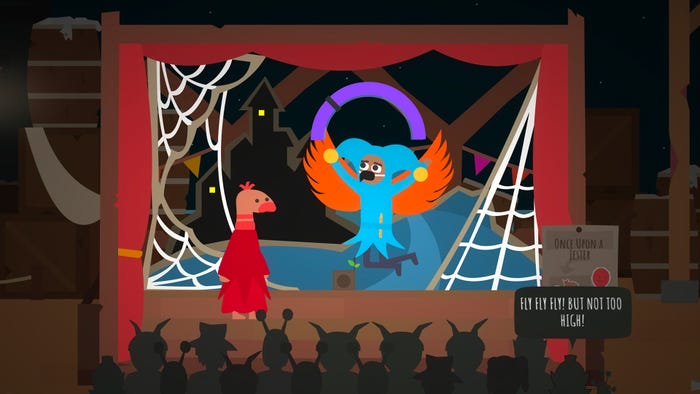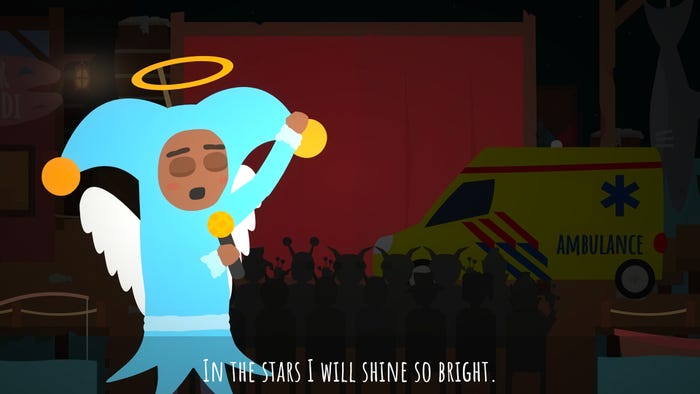Trending
Opinion: How will Project 2025 impact game developers?
The Heritage Foundation's manifesto for the possible next administration could do great harm to many, including large portions of the game development community.

Mark Lohmann and Kyon Edelenbosch talk about the appeal of bringing their love of improvisational theater and music to the world of video games with Once Upon a Jester.

The IGF (Independent Games Festival) aims to encourage innovation in game development and to recognize independent game developers advancing the medium. Every year, Game Developer sits down with the finalists for the IGF ahead of GDC to explore the themes, design decisions, and tools behind each entry. Game Developer and GDC are sibling organizations under Informa Tech.
Once Upon a Jester sees players travelling across a ridiculous kingdom and putting on improvised theater acts, letting them get creative with how these hilarious plays come together.
Game Developer sat down with Mark Lohmann and Kyon Edelenbosch, the game’s creators, to talk about the challenges of bringing the creativity of improvisational theater and music to games, how they developed mechanics that would bring a degree of challenge to improvisation without stifling the player’s ability to do what they like, and how they reshaped “failures” and player mistakes into an excuse for more jokes to make even screw-ups feel fun.
Who are you, and what was your role in developing Once Upon a Jester?
We’re Mark Lohmann and Kyon Edelenbosch. We’re both musicians from the Netherlands and good friends. Both of us do a bit of everything to create our games and we do a lot of stuff together like coming up with the story and concepts for the game, as well as writing the music and the dialogue. A lot of this happens naturally when we’re just hanging out (to be honest, 50% of our ideas come when we’re not even working on the game but are just having fun with friends or whatever).
Even though we do a lot of stuff together, Kyon tends to do more programming and Mark does more environment art.
What's your background in making games?
We both have a very similar background; we started making games in Gamemaker when we were kids and kept doing that until we were teenagers. Then, we both switched over to making music and then, in our mid twenties, we started combining music and game development. And that’s actually the point where we met. It was incredible to meet someone so alike in their interests, humor and background. We started doing game jams and eventually worked on Everybody Wham Wham, our first commercial game.

Images via Crunching Koalas
How did you come up with the concept for Once Upon a Jester?
We were talking a lot about how to combine our improvised voice-acting and songwriting with more gameplay, and so we started talking about a theater game where you can play your own shows and progress through the adventure that way. From there on we came up with the characters and the story.
What development tools were used to build your game?
Gamemaker and Adobe Animate.
What challenges did you face in bringing the creative, open nature of improvised theatre to video games? How did you give the player the ability to improvise on the fly within the game?
The toughest part was actually turning it into a fun game. You don’t want to punish the player for taking the freedom to do what they want, but there has to be a challenge to it. In the end, the player won’t get punished if they don’t listen to what the audience wants, but they will get rewarded if they do. So, there’s no game over or anything; you just progress a bit faster.
We’re using pretty simple gameplay mechanics that show up in different ways throughout the game, so the player doesn’t have to learn a lot of complex key combinations. This really helped with just throwing the player into a new show and letting them figure it out and improvise on the spot. Besides that, we’ve created a lot of branches in the in-game theatre shows, which also helps with the feeling of improvising.
What thoughts went into designing ridiculous choices for what to do during the shows? Can you tell us about your process for coming up for these decisions? Can you tell us about some of the ones that didn't make it in the game?
Just like how we come up with new game ideas, we just hang out a lot of the times and talk about the game (because we can get kind of obsessed with stuff we work on) and often we just start joking. If we both think it’s funny, we just quickly put it in the game and try not to overthink it. A lot of the later part of the game was thought of in the car while we were on a road trip through Europe. I remember us saying a lot of the times “that’s hilarious, but we really can’t put that in the game”, and I think almost all those ideas went in the game anyway.
About the ideas that didn’t make the game: we had a whole show in the game where you would perform with a ventriloquist puppet called ‘Comedy Joe’ (he had his own theme song and everything). But something about that show didn’t quite click, so we scrapped it. Another idea that was outside of the theater shows was one where Sok would get abducted by a UFO, and then a whole synth musical song with the aliens would start. We had to scrap it because there was simply no time anymore…Maybe one day we’ll finally get to make that UFO scene…*sigh*

Images via Crunching Koalas
How did you design the meter-like mechanic that affects what happens when players try to do something? How did you work it into the various actions in intuitive ways? What drew you to create such a straightforward means of "performing?"
Honestly, we were struggling a lot with what the gameplay would be and how to keep it simple. We’re not really into a lot of different keys to use and tons of tutorials. So, we came up with this meter-like mechanic (which we started calling “The Mechanic”) to show players in a pretty simple way what to do. Since there would be many different situations where Jester would do something completely different, we wanted a simple design that would stay the same no matter what happened on stage so that the player always knew what to do.
Screwing up can be just as much fun as doing something correctly in Once Upon a Jester. How did you make "failure" appealing, and why did you choose to do so?
We didn’t want the player to feel bad (we just don’t want people to feel bad in general, I think) when they did something wrong. Therefore, we try not to punish players—only reward them in case they do it correctly. Another important reason is that we just want to put as many of our silly jokes into the game was we can, and all those moments where something could go wrong are perfect for that.
What thoughts went into creating the art style for the game? What made it feel right for the lighthearted game you wanted to create?
The art style naturally evolved into what it is in Once Upon a Jester. If you look at our previous games from game jams and stuff (Tower Guy, The Dragon of Terzaville Who Got His Neck Broken in a Weird Accident, Midnight Ghost Ride, Crash FM) you kind of see our style develop. But we always worked in colorful vector art. We hope to get better at it each game, since we’re also still figuring out what works best. We think our next game, Bonnie Bear, already looks a bit better since we’re started experimenting with shaders and more detailed assets (while keeping the simplicity of our style).

Images via Crunching Koalas
Also, what ideas went into creating a wild world filled with bizarre, hilarious characters to meet? How did you design characters and locations to weave further silliness into the game's world?
We have a discord channel where we both just post random sketches of characters, and some of them inspire areas for the world, which in turn inspire us to create more character for that vibe. A lot of the sketches don’t get used but might become characters in next games.
You wrote music that would enhance the wacky, silly, and touching moods of the game. Can you tell us a bit about the ideas that went into the game's music? How you captured that explorative feeling of improvised theatre within the music itself?
Writing the songs for our games always goes super quickly. We’re both songwriters in other projects, too, but we’re always surprised how easy it feels to write for Bonte Avond stuff compared to other times when we try to write. It’s partly because we work together so well. One of us sings a little melody, the other person hears something in that melody and adds something, and before we know it we’re writing the lyrics and the song is finished.
It’s also nice to have a character with personality and a situation, which makes writing the songs really fun and natural. Since songwriting is, in essence, a form of improvisation, it really fits the game. Besides that, when we record, we often keep first takes and even “bad takes.” We want it to feel real and on-the-spot.
Humor can be very challenging to do, especially in a video game. How did you craft a game about cracking the player up, and what difficulties came from making such a funny experience? Likewise, what benefits came from working on something you built to make people laugh? How did that affect you in positive ways as a creator?
When we’re together, we’re basically laughing 70% of the time, and since we put so much of ourselves in the game, it wasn’t really difficult. The real challenge was creating a story that’s not only gags and jokes, but also meaningful and one that makes sense. Not sure if we succeeded, but we tried!
While making the game, we could get pretty negative and critical about what we were doing, which was sometimes tough. We were thinking like “who would even play this?”, “is this even fun?” etc. But I remember showing our game at a few showcases and seeing people have so much fun and laugh out loud. That was really heartwarming to see, and it helped us a lot with motivation and realizing that we were making something worth playing.
You May Also Like